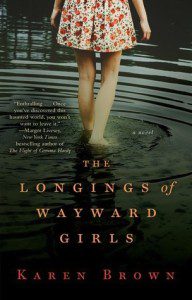
The title of Karen Brown’s début novel, The Longings of Wayward Girls, is an apt fit for this story with its persistent curiosity about indiscretion and desire. But the word wayward sticks a little, draws attention to itself. What does it mean to be a wayward girl? Is this about being willful, difficult and capricious? The emphasis here is on perverse behavior or character—and a not-so-easy one at that. But wayward also hints at a journey, an idea of wandering; it conjures up phrases like “the way forward,” or it highlights an opposite direction, “homeward.”
It is worthwhile pushing a little precision here, because the women and girls within the pages of Brown’s novel are not just wayward, they are lost. This darker, more concrete meaning of wayward is really what hums throughout the story—babies lost at birth, girls lost in the woods, women lost to their own purpose, lost to their families. In some sense, the parade of wayward behavior within these pages is trumped by an even greater carnival of loss—lost items, lost memories, lost siblings, lost loves, lost lives.
The book’s fictional window opens out onto two different summers in the life of its protagonist, Sadie Watkins Stahl—1979 and 2003. Both summers involve death, but it is important to note that the deaths in each story occur at opposite ends of those parallel seasons. In 1979, when Sadie Watkins is 12, the story moves the reader toward a death that is hugely significant to the rest of Sadie’s life. And in 2003, Sadie Stahl, now married with two children, is moving away from the death of her third child, a stillborn little girl she had already named Lily.
This backward and forward movement is a curious one—in the past sections Sadie is looking ahead, in the present Sadie is looking backward, and the book revolves around the strain created in this shifting, how memory informs and transforms the present, how the past reaches forward to define and challenge a person’s character. Through all of this, Brown keeps her reader fastened to a single emotion: grief. In a book that harbors so much loss, it makes sense that the most thorough emotional exploration has to do with grieving and how it works its way through an individual over time, even a very long time.
Cleverly, The Longings of Wayward Girls is also very much about desire, and in this way asks the reader to consider our sometimes parallel, sometimes conflicting drives for love and death. This is familiar territory for readers of Brown’s 2012 story collection, Little Sinners, and here, as in that earlier collection, Brown’s discussion and exploration of the nuances of desire is excellently done. In both her stories (two of which figure in Longings in expanded and updated form) and the novel, Brown examines the complications of desire and how often it is tied to memory and to the space that exists between who we really are and who we would like to be.

Nowhere is this clearer than in one of the opening scenes, in which grown-up Sadie runs across Ray Filley at a gas station in town. Here is a man she hasn’t seen in years but with whom many aspects of her life had once been intricately linked. Learning about those various connections between Sadie and Ray is what drives the novel forward, but here in this scene, all that matters is the moment Ray sees Sadie and the brief shock and confusion that registers across his face.
“You thought I was Laura Loomis,” Sadie says to Ray, revealing to the reader that Sadie has often been mistaken for another person, a girl who disappeared from their shared childhood neighborhood, never to return. Ray quickly denies the charge, mentioning Sadie’s mother instead. And suddenly there are four women standing at this gas station with Ray: Sadie Watkins, Laura Loomis, Clare Watkins (Sadie’s mother), and, perhaps most importantly, Sadie Stahl—the married woman that Sadie Watkins has become since she last saw Ray Filley as a teenager. Here, for just a brief moment, these four women are manifestations of one woman. They each represent a possibility, an incarnation.
As readers, despite the novel’s preoccupation with past events and Brown’s subtle unwillingness to use Sadie’s married name again, we are actually most interested in Sadie Stahl. She is the character who will challenge both our expectations and our sympathies. She is the character through whom Brown meditates most on the ideas expressed in the ambiguity of that word wayword: longing and loss, memory and desire. She is both consciously and unconsciously distinct from as well as enmeshed with Sadie Watkins—a highly effective way of maintaining tension throughout the book. Finally, she is also the only character whose transformational momentum matters to the story and to the reader.
The Longings of Wayward Girls embodies several known genres: it is alternately a literary thriller, a coming-of-age novel, and a complex domestic drama. It is about mothers and daughters, husbands and wives, about infidelity, about parenthood and childhood, about the strange and difficult crossing from one to the other. It is about our need to tuck unwanted imperfections beneath our perfected suburban facades. And, ultimately, it is about wanting the past to explain away the present and how false that desire eventually proves.




